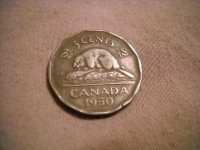Since 1866, except for four years during WWII, the US nickel has been 75% copper and only 25% nickel, an alloy referred to as cupro-nickel. Like other primarily copper coins, they become what numismatists refer to as "environmentally damaged" when dug out of the ground.
Recently I dug a 1950 Canadian nickel deep enough to know there was no chance of it being a recent drop. And it came out of the ground looking good. So I'm thinking the Canadian nickel metallic composition must be different than the US.
Sure enough, the Canadian nickel was minted with 99.9 pure nickel from 1922-1942, 1946-1951 and 1955-1981.
Recently I dug a 1950 Canadian nickel deep enough to know there was no chance of it being a recent drop. And it came out of the ground looking good. So I'm thinking the Canadian nickel metallic composition must be different than the US.
Sure enough, the Canadian nickel was minted with 99.9 pure nickel from 1922-1942, 1946-1951 and 1955-1981.




 Great picture of the Nickel .Nice lighting and backround , I have a lot of trouble getting that right .
Great picture of the Nickel .Nice lighting and backround , I have a lot of trouble getting that right . Math hurts. Thanks for the informative and interesting post. Also, thanks for correcting that mistake before I dived into the Canadian nickel hoarding fray.
Math hurts. Thanks for the informative and interesting post. Also, thanks for correcting that mistake before I dived into the Canadian nickel hoarding fray.